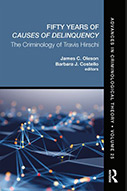Fifty Years Of Causes Of Delinquency: The Criminology Of Travis Hirschi. Advances In Criminological Theory, Volume 25

Editors: James C. Oleson and Barbara J. Costello
Publisher: New York: Routledge, 2019. 394p.
Reviewer: Michael R. Gottfredson | November 2020
Travis Hirschi’s book, Causes of Delinquency, is, by many measures, the most important work published in criminology in the last 50 years. A model for theory development and explication, Causes not only presented Travis Hirschi’s novel control theory, it specified ways to contrast it with other perspectives, demonstrated clearly major advantages of questionnaire-based, self-report surveys for academic criminology, and set standards for parsimony, clarity, and testability for theoretical criminology that prevail today. Its publication changed just about everything in theory and ushered in (along with others, of course) a wave of research based on systematically asking respondents about their own behavior as a method of measuring delinquency and crime. Before Causes, it could be argued that the prevailing organizing view of criminology in the United States was provided by the sociologist Edwin Sutherland’s idea of differential association, a view integrated into many specialties in the field in his very widely used text, Principles of Criminology. A few years after the publication of Causes, texts changed, the way theories were construed and tested changed, and the teaching of criminology changed. Hirschi’s writing its terms and concepts are now part of essential criminological vocabulary. Few individual works have had the influence in any discipline that Causes of Delinquency has had in criminology. This book of essays written by students and colleagues of Travis celebrates the book on the remarkable occasion of five decades of continuous influence.
If the chapters in Fifty Years of Causes of Delinquency only served as a tribute to the historical influence of Hirschi’s work, this would be a very welcome volume. But collectively, the book does much more than that—these essays and empirical studies illustrate both the historical and the contemporary relevance of the ideas Travis first presented half a century ago. Two essays by James Oleson, one of the editors of the volume, first situate social control theory in time and in subsequent influence (in the introductory piece, “The criminology of Travis Hirschi: Social control the beyond”) and then probe the connections between Causes and some of Hirschi’s subsequent work on age and A general theory of crime. In combination, they frame a set of issues that set the stage for considerable future work on the nature and implications of control theory (“The rabbit and the duck: The evolution of Hirschi’s control theory”). These essays, which “bookend” the volume, are both stimulating and challenging contributions to modern considerations of the role of control theory in the future of criminology.
So too are the significant essays by Robert Agnew and Marcus Felson, both of whom are, of course, authors of critically important modern theoretical contributions (general strain theory and routine activity theory, respectively). Each illustrates the influence of social control theory on their own thinking, and each offers reflection of how their own theoretical ideas accommodate essential control theory principles and concepts. The discussion by Agnew (“The rise of social control theory, fall of classic strain theory, and reconciliation between social control and general strain theory”) illustrates control theory concepts within his own important perspective. As is well known, earlier versions of strain theory did not receive strong endorsement in Causes, a circumstance, as described in this chapter, that helped motivate the substantial and now influential restatement of the ideas in general strain theory, such that all modern considerations need focus on the ideas presented in Agnew’s modern version. The intriguing essay by Felson (“Using a wider control theory to teach criminology”) imagines control theory as an overall framework to teach a considerable body of criminological knowledge, a fascinating—and obviously very general– perspective. The connections between elements of control theory and routine activity theory (and situational theory) are numerous, as made plain by this framework.
In fact, the chapters in Fifty Years uniformly contribute reflections on the role of Causes in criminology, and insight about its continuing place in the field. These papers themselves will very likely stimulate considerable interesting and diverse scholarship in the field. Included are several imaginative and timely empirical studies: 1) a true replication of many of the key findings in the original study based on instruments created by Travis and others thirty years later by Barbara Costello and Bradley Anderson (“Causes of delinquency revisited: Key findings from the Fayetteville replication study”). The chapter shows remarkably consistent associations across time and place in a nearly literal replication of key concepts used by Hirschi; 2) a new study looking at the girls in the original Richmond Youth Survey presented in Causes (Hirschi presented data only on boys) by Stacey Nofziger (“Beyond the footnote: A return to the girls in the Richmond youth project”). This insightful discussion of predictions from control theory are then coupled with careful empirical analysis, resulting in an important contribution about the generality of the theory (a chapter that is also, as Nofziger points out, a form of replication study); 3) a sophisticated study, by Constance Chapple and Julia McQuillan, extends ideas about gender and crime to the concepts from social and self control theory, and then tests them with national self-report data (“A matter of control: Social controls and the gender gap in delinquency”). Their careful study provides a significant contribution to an enduring issue in the explanation of delinquency; 4) Mitsuaki Ueda and Hioshi Tsutoti present a highly original study that advances the reasonable position that Causes and A general theory of crime are compatible theories, using common foundational assumptions. They then illustrate this by using a novel set of data from Japan (“A test of Hirschi’s redefined control theory in the far east”); and 5) a significant theoretical and empirical contribution by Alexander Vazsonyi and Magda Javakhishvili (“Infant socialization and the development of self-control: Filling in the gap”). This study illustrates the tremendous importance of early socialization and puts together the logical links between infant socialization, social bonds and self control. They deploy a large self-report data set that enables their creation of measurement models that include both bond and self control concepts, showing a critical importance of bonds early in life for the development of self control.
Other chapters in the volume explore a range of contemporary theoretical issues stimulated by Causes. Among them is an insightful essay on the control theory assumptions about human nature by Miyuki Tedor and Trina Hope (“Social control theory and human nature”) that brings the foundational stance of classic control theory well-forward. They not only discuss historical connections to the assumption, but tie contemporary research and discussion around its implications. Also included is a masterful piece of scholarship by Serrano-Maillo (“Linking bond theory to drift theory”) exploring the theoretical connections between bond theory and the theory of drift by David Matza. This highly original and compelling discussion integrates the ideas of morality and drift, and social and self control, an integration entirely missed in much contemporary scholarship.
What is remarkable and well-illustrated by Fifty Years of Causes of Delinquency is how Causes remains an utterly contemporary work. Stimulating, essentially consistent with the best modern scholarship on crime and delinquency, of enormous scope, at once parsimonious and deeply insightful, it changed criminology in significant ways—and continues to stimulate some of the field’s very best scholarship.
Michael R. Gottfredson, Chancellor’s Professor, University of California, Irvine.


